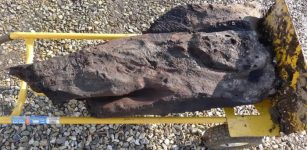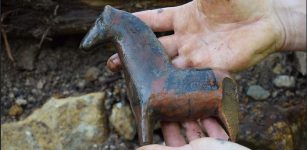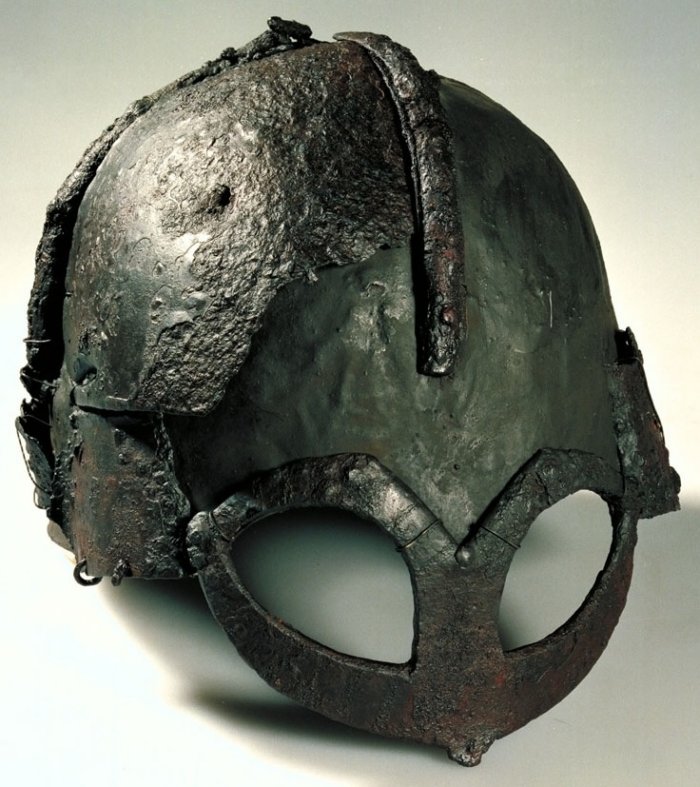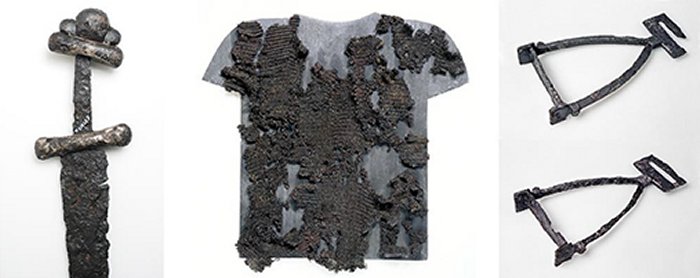Unique Gjermundbu Helmet – Why Has Only One Viking Age Helmet Been Found In Scandinavia?
Ellen Lloyd - AncientPages.com - Over the years, archaeologists have discovered many precious Viking Age artifacts, such as unique Viking jewelry, weapons, ritual objects, pieces of clothes, and even ships.
Gjermundbu helmet - Credit: NTNU Vitenskapsmuseet
Isn't it strange that scientists have only found one Viking Age helmet in Scandinavia?
How can the lack of Viking Age helmets be explained?
The helmet was accidentally discovered on the farm Gjermundbu in Haugsbygd in Ringerike in 1943. Scientists found a burial chamber of historical value dating from the Viking era when scientists examined the area.
Remains of two males were found along with other Viking artifacts such as two swords, two axes, two spearheads, board games, and an almost intact chain mail.
The Vikings who had been put to rest there were fully equipped to continue their afterlife in Valhalla, where Viking warriors dwell after death.
Viking Age artifacts discovered at Gjermundbu, Norway. Credit: Cultural History Museum, UiO / Vegard Vike / Ove Holst / Ellen C. Holte
The Gjermundbu helmet was examined and dated to around the later 9th century. Having a fixed visor of the characteristic 'spectacle' form, it was an expensive helmet only a few could afford. Most likely, it belonged to a powerful Viking chief. On the back of the helmet were metal plates that protected the warrior's neck. Many warriors could only dream about wearing such a special iron helmet during the Viking Age.
The fact that scientists have not discovered more Viking Age helmets cannot be easily explained, but some theories could shed light on the subject.
One possibility is that the modern image of the Vikings is simply wrong. We often picture a Viking as a warrior who jumps off his ships, waving a sword and wearing a large helmet. What if Vikings did not wear iron helmets because they were too heavy?
Vikings were very mobile, and heavy helmets could do more harm than good when a warrior engaged in battle. He had to be able to move very fast, and heavy military equipment was a disadvantage.
Vikings possibly used pointy hoods as protection from the weather or leather helmets, historians say
Scientists from Norway think only members of a Hird wore iron helmets. As previously discussed on Ancient Pages, members of a Hird were professional Viking warriors and bodyguards who protected their leader day and night.
Vikings who worked in a Hird were greatly rewarded for their services and probably had access to the best military equipment. A mighty Viking chief could have up to 60 warriors in his Hird. If all these Vikings wore iron helmets, then why have we only found one Viking Age helmet so far?
It seems much more plausible that iron helmets were rare during the Viking Age. The question is - how uncommon were Viking Age iron helmets?
Updated on September 30, 2022
Written by Ellen Lloyd – AncientPages.com
Copyright © AncientPages.com All rights reserved. This material may not be published, broadcast, rewritten or redistributed in whole or part without the express written permission of AncientPages.com
Expand for referencesGrieg, S. - Norske Oldfunn VIII, Gjermundbufunnet. Oslo
Orrling, C. - Vikingatidens ABC. Historia i fickformat. Uppslagsord Gjermundbu. Stockholm
Vike, V. - Brynjevev : metallografisk analyse av brynjematerial ved Oldsaksamlingen i Oslo.
More From Ancient Pages
-
 Mysterious Sarcophagi Belonging To The Chachapoyas The Cloud People
Archaeology | Mar 4, 2014
Mysterious Sarcophagi Belonging To The Chachapoyas The Cloud People
Archaeology | Mar 4, 2014 -
 Rare Gilded Mask Discovered On Mummy Of Ancient Egyptian Priest Serving Sky Goddess Mut
Archaeology | Jul 17, 2018
Rare Gilded Mask Discovered On Mummy Of Ancient Egyptian Priest Serving Sky Goddess Mut
Archaeology | Jul 17, 2018 -
 The Seal Of Solomon, The Fifth Element And The Andromeda Constellation Reveal An Intriguing Connection
Ancient Symbols | Mar 8, 2018
The Seal Of Solomon, The Fifth Element And The Andromeda Constellation Reveal An Intriguing Connection
Ancient Symbols | Mar 8, 2018 -
 Surprising Discovery Of Oldest Decoratively Carved Wood In Britain
Archaeology | Jun 7, 2023
Surprising Discovery Of Oldest Decoratively Carved Wood In Britain
Archaeology | Jun 7, 2023 -
 Rare Discovery: Giant Stone Artifacts Found On Ice Age Site In Kent
Archaeology | Jul 6, 2023
Rare Discovery: Giant Stone Artifacts Found On Ice Age Site In Kent
Archaeology | Jul 6, 2023 -
 Ancient Footprints Offer Evidence Humans Wore Shoes 150,000 Years Ago – Scientists Say
Archaeology | Sep 11, 2023
Ancient Footprints Offer Evidence Humans Wore Shoes 150,000 Years Ago – Scientists Say
Archaeology | Sep 11, 2023 -
 Terrifying Buggane: Demonic And Tyrannical Celtic Demon That Hated Churches And Set Them On Fire
Celtic Mythology | Jul 14, 2017
Terrifying Buggane: Demonic And Tyrannical Celtic Demon That Hated Churches And Set Them On Fire
Celtic Mythology | Jul 14, 2017 -
 Eros: Remarkable Greek God And One Of Those Who Created Everything That Exists Today
Featured Stories | Apr 19, 2023
Eros: Remarkable Greek God And One Of Those Who Created Everything That Exists Today
Featured Stories | Apr 19, 2023 -
 Neanderthals Cared For Each Other And Survived Into Old Age – Study Shows
Evolution | Nov 2, 2023
Neanderthals Cared For Each Other And Survived Into Old Age – Study Shows
Evolution | Nov 2, 2023 -
 Danger Lurking In The Woods – Strange And Unexplained Sightings – Part 2
Featured Stories | Jul 7, 2018
Danger Lurking In The Woods – Strange And Unexplained Sightings – Part 2
Featured Stories | Jul 7, 2018 -
 Mystery Of The Copper Age ‘Ivory Lady’ Solved
Archaeology | Jul 6, 2023
Mystery Of The Copper Age ‘Ivory Lady’ Solved
Archaeology | Jul 6, 2023 -
 World’s Oldest Dala Horse Discovered In Sweden
Archaeology | Jul 18, 2020
World’s Oldest Dala Horse Discovered In Sweden
Archaeology | Jul 18, 2020 -
 Mystery Of The Ancient Okunev Culture: Skeleton Of 4,500-Year-Old Noblewoman With Links To Native Americans Discovered In Siberia
Archaeology | Sep 9, 2016
Mystery Of The Ancient Okunev Culture: Skeleton Of 4,500-Year-Old Noblewoman With Links To Native Americans Discovered In Siberia
Archaeology | Sep 9, 2016 -
 Day Of The Dead: From Aztec Goddess Worship To Modern Mexican Celebration
Ancient Traditions And Customs | Oct 30, 2019
Day Of The Dead: From Aztec Goddess Worship To Modern Mexican Celebration
Ancient Traditions And Customs | Oct 30, 2019 -
 Cuchulainn: Irish Mythical Hero And His Cruel Magical Spear Gae Bolg
Celtic Mythology | Jun 6, 2017
Cuchulainn: Irish Mythical Hero And His Cruel Magical Spear Gae Bolg
Celtic Mythology | Jun 6, 2017 -
 Ancient Mystery Of The American Southwest – Unusual Skeletons And Mummies – Part 2
Civilizations | Jul 24, 2018
Ancient Mystery Of The American Southwest – Unusual Skeletons And Mummies – Part 2
Civilizations | Jul 24, 2018 -
 Curly Hair Protected The Brain Of Early Humans And Helped It Grow
Human Beginnings | Aug 31, 2023
Curly Hair Protected The Brain Of Early Humans And Helped It Grow
Human Beginnings | Aug 31, 2023 -
 Who Was “Shimon”, Whose Name Appears On A 2,000-Year-old Hebrew Inscription?
Archaeology | May 20, 2023
Who Was “Shimon”, Whose Name Appears On A 2,000-Year-old Hebrew Inscription?
Archaeology | May 20, 2023 -
 Machine-Learning Model Can Detect Hidden Aussie Rock Art
Archaeology | Jun 28, 2022
Machine-Learning Model Can Detect Hidden Aussie Rock Art
Archaeology | Jun 28, 2022 -
 Yasuke – The First Black Samurai Caused A Sensation In Japan
Featured Stories | Oct 25, 2019
Yasuke – The First Black Samurai Caused A Sensation In Japan
Featured Stories | Oct 25, 2019


